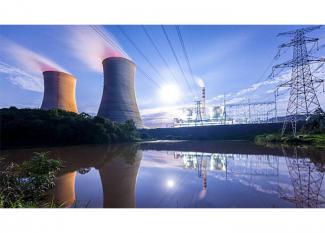NETL researchers such as Dominic Alfonso are using advanced computational tools to repurpose carbon dioxide (CO2) from a waste product into chemical building blocks to manufacture fuels and a range of high-value items.
The work undertaken by Alfonso and other members of NETL’s Computational Materials and Engineering Team focuses on recycling CO2 generated by fossil energy plants and other industrial sources into chemicals, alcohols, acids and syngas, which are used to manufacture fuels, polymers and fertilizer.
“For more than a century, we have used fossil fuels to produce our electricity and for a variety of other purposes. However, when we extract energy from fossil fuels, we create CO2, the primary greenhouse gas emitted through human activities,” Alfonso said.
“We can address this issue by using CO2 from factories and power plants as a chemical feedstock. Waste CO2 emissions can become something you can recycle into valuable products, providing a strong financial incentive to reduce the amount of CO2 released into the atmosphere,” he added.
Alfonso’s research is dedicated to advancing the development of CO2 recycling through electrochemistry. In the presence of electricity, CO2 molecules and protons from splitting water molecules react on an appropriate catalyst to form chemical building blocks for hundreds of useful products.
Whereas traditional reaction processes often require high temperatures and pressures, electrochemistry can be conducted at near room temperature and ambient pressure using electricity from a renewable energy source such as wind, solar or geothermal, which makes the process more efficient and environmentally benign.
NETL researchers use a variety of cutting-edge experimental and computational techniques to understand and optimize catalysts and open new doors to CO2 conversion. The type of chemical building blocks to be produced by recycling CO2 is also determined by the identity and characteristics of the catalyst.
Nanometallic-based catalysts are especially effective because their high surface area can dramatically increase catalytic activity. The ability to identify low-cost, abundant and high-activity catalysts that can guide the reaction toward making only the desired product is the challenge that NETL is addressing through advanced computer modeling and simulations.
NETL’s goal is to discover precise catalyst recipes. Researchers want to know what types of catalysts work best to selectively and efficiently turn CO2 into specific chemical compounds. A major objective of nanocatalyst research is to create efficient catalysts that have high stability and long lifespans by controlling the size, shape, surface composition and electronic structure.
“When it comes to improving a catalyst’s performance, one of the key things is how to make them more selective, so they generate just the target product and nothing else,” Alfonso said.
Tools such as NETL’s Joule 2.0 supercomputer are used as platforms to simulate experiments and develop models to identify active sites and understand how the reactions proceed.
Supercomputing is essential in achieving NETL’s mission to discover, integrate and mature technology solutions that enhance the nation’s energy foundation and protect the environment for future generations. By expediting technology development through computational science and engineering, Joule 2.0 helps NETL cut costs and save time. “Joule is our workhorse,” Alfonso said.
A patent developed by Alfonso, a co-inventor, and NETL researchers Douglas Kauffman, Christopher Matranga, Paul Ohodnicki, Xingyi Deng, Rajan Siva, Rongchao Jin and Chenjie Zeng defined a method to control and isolate differentially charged gold (Au25) nanocatalyst clusters from a mixed solution.
The invention (USPN 10,385,726) was significant because charge specific Au25 clusters have demonstrated the ability to convert CO2 to carbon monoxide (CO) with 99-plus percent efficiency. CO is a feedstock in the production of chemicals ranging from acetic acid, which is used in many household cleaning products, polycarbonate plastics and methanol, which is used in thousands of everyday products, including fuels, paints, adhesives, fertilizers and windshield fluid.
Gold is one of the most selective catalysts for electrochemically converting CO2 into CO, but its expense is a major drawback. Meanwhile, cheaper copper catalysts typically show poor product selectivity and produce a larger variety of chemicals with lower efficiency.
In a research study, NETL’s gold-copper alloy nanocatalysts demonstrated four to eight times higher performance than state-of-the-art gold nanocatalysts on a precious metal basis. NETL research combined effective expertise in experimental catalyst testing, computational modeling and synchrotron-based X-ray characterization to obtain an atomic-level understanding about how the catalyst structure and surface groups sustained selective CO2 conversion.
“The bottom line is we are paving the way to developing less-expensive CO2 utilization catalysts that can convert CO2 into useful products society needs while dramatically reducing the amount of carbon emitted into the atmosphere,” Alfonso said.
DOE’s Carbon Utilization Program aspires to develop technologies to transform CO2 and other carbon byproducts and wastes into valuable products in an efficient, economical and environmentally friendly manner. Research and development activities address the challenges and potential opportunities associated with integrating a CO2 utilization system with various power and industrial plants or carbon capture systems, such as waste heat integration, wastewater reduction, flue gas contaminant reduction and reduced energy demand.
The success of carbon capture, carbon recycling and carbon utilization initiatives, which NETL has advanced in partnerships with industry and top research universities, is critical to ensure a cleaner environment while continuing to use the nation’s abundant coal and natural gas resources to produce reliable and affordable electricity.
The U.S. Department of Energy’s National Energy Technology Laboratory develops and commercializes advanced technologies that provide reliable and affordable solutions to America’s energy challenges. NETL’s work supports DOE’s mission to advance the national, economic and energy security of the United States.




